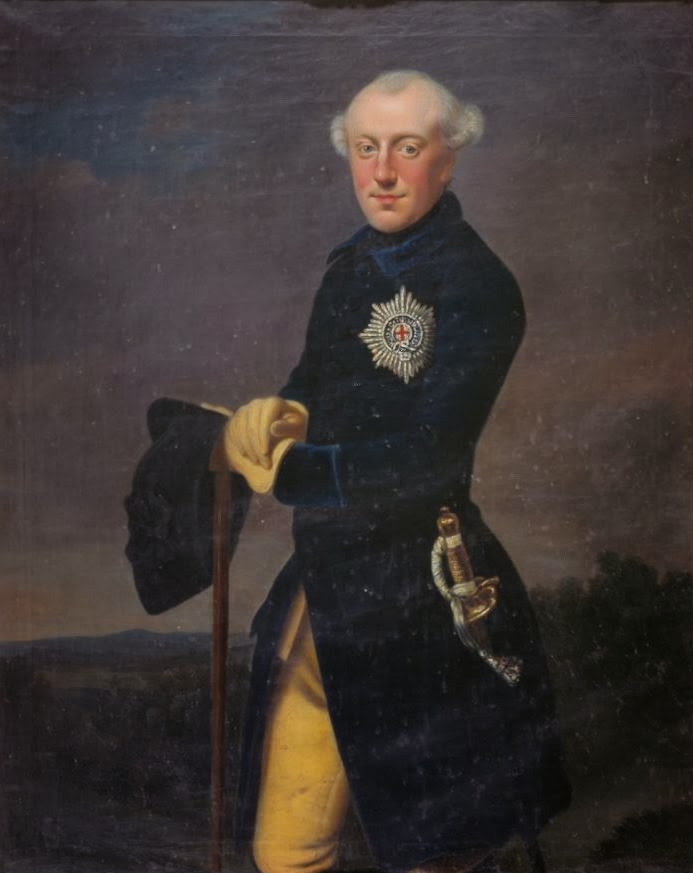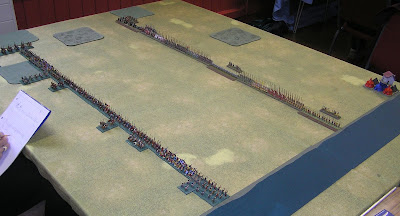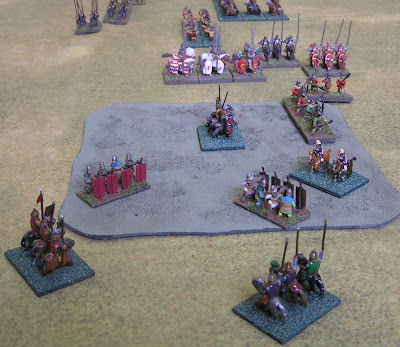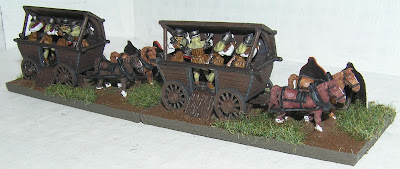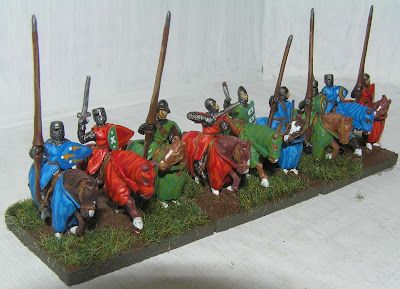Peter K Demanded a Rematch after being crushed!
Following on from the 32-0 win on the 17th January Peter K demanded a rematch because he needed some more practice with his chosen army.
We both chose to invade in Summer and this time I was the defended with no weather effects at 6 AM. I elected to place a Waterway and BUA to close down at least one side of the table along with two half features of Boggy Rough Going. Peter placed three 0.5 FE H[G] bare gentle hills. Apart from one piece of RGo the terrain placed almost no part in the game. I placed my baggage inside the BUA and put down my Field Fortifications [TF] in three groups spread along the table and deployed my commands 3 - 2 - 1 from left to right. Peter put his CinC's command in the centre flanked by the other two commands. See the first two pictures for the table layout and initial deployment positions.
After some inconsequential movements which allowed me to push forward my two Reg Mounted Crossbowmen followed by the Reg Bd X Planconmen to dispute the RGo to my right front. I was really surprised that Peter behaved so defensively for so many bounds. Because it wasnt a tournament game I moved forward away from the TF to make a battle of the game which given what happened much later was probably a really bad mistake. Peter yet again got broken up due to my mounted crossbowmen braking his line apart and once he rolled the inevitable low PIP dice for that command meant that some of his knights because uncontrolled and charged into the RGO towards my crossbowmen.I managed to get three of the Planconmen elements lined up opposite his inferior archers and pushed forward to contact. The first round resulted in my recoiling back !. I then pushed back in and killed two Irr Bw I whilst my other crossbowmen took out an Irr Kn F to their front. His knights were now all over the place and crashed into my front one at a time. His general for this command hit the flank of one of my Plancomen and dragged it out into the open ground but luckily for me we drew the combat for that turn whilst the other three Planconmen were busily taking out the remaining four Irr Bw I to their front.
The loss of these six Irr Bw I along with the two Irr Kn F was enough to break this command which then fled back towards the rear leaving me to try and maintain control. I rolled high for PIP and allocated sufficient PIPs to reform the remaining Bd X and Bw I into two groups. It was at this time I managed to get into bow range from this commands now demoralised generals element which meant I had a good chance of destroying it if I was lucky with the dice roll. The CF was 4 to 3 in my favour when Peter rolled a 1 which meant all I needed to do was roll 3 or more to kill his fast knight general, which is exactly what happened. Peter then threw in his other two commands to try and get a result and promptly lost his other sub-general and another knight to a pair of really bad dice roll and left another knight sticking frontally double overlapped against my pikes.I was at this time my dice luck evaporated and I lost this combat in my turn to a 6 - 1 throw. Peter them threw in his CinC's knights and within two bounds had swept away virtually all of my pikes after I rolled no more than three in any of the next two bounds to lose 20 elements of pikes from both commands which was enough to break both of these commands and along with it my army. Had my line of pikemen held out a bit longer I had got my knights lined up opposite the flank of his CinC's group of Irr Bw I and the three Planconmen elements were heading towards his baggage.
So Peter managed to snatch victory from the jaws of defeat with a 9-1 victory which after taking into account the 40.88% casualties he had lost from his army which was only 1,5 EE away from breaking itself gave him a 27-5 BHGS victory. It was a long drawn out slow game due to Peter taking full use of the 7.5 hours we have to play on a Sunday.
We are now scheduled for another game on the 14th of February when Peter will be taking on my Samanids with his Italo-Ostrogoths for another practice game.
Below are the pictures I took during the game which clearly shows the hard fought battle for that single patch of RGo out to my right flank.
